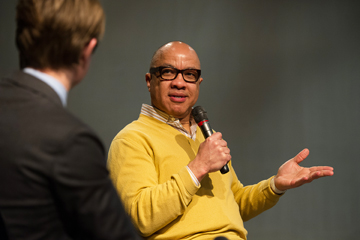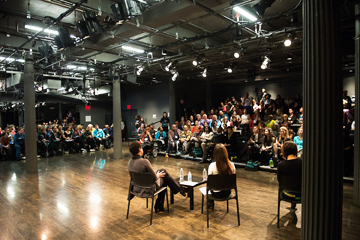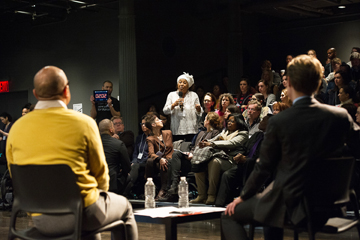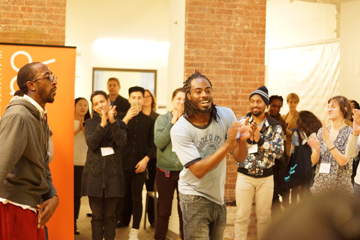Dance: Dance/ NYC Symposium. What is Equity?
By Dawn Lille
ART TIMES online April 2016
 Darren Walker Photo by Christopher Duggan |
Dance/NYC is dedicated to promoting every aspect of dance and its performance in the metropolitan area. Foremost to the workings of the organization are values of equity and inclusion. On February 28 they hosted their 7th annual Symposium, a full day event that attracted over 500 dance leaders, performers and supporters to explore economic, educational, and technological issues, as well as those of racial and disability equity. The latter was covered extensively in a pre-symposium the previous day, which resulted in the release of a report, “Disability. Dance. Artistry.”
Attendees were invited to explore the connections between dance as an art form and the city. With over 1,200 dance makers and companies and thousands of dancers in this fairly small area, not to mention governmental, educational, artistic and philanthropic organizations, the task was how to think ahead, forge partnerships and be inclusive in planning within a technological future.
Darren Walker, President of the Ford Foundation, was the keynote speaker. It is significant that he represents a major foundation that has changed its goals in order to focus on equity.
Scattered throughout the day were discussions and workshops, plus legal and financial clinics. Some were organized according to subject tracks, one of which was Voices on Dance and Race, on which this reporter concentrated.
The panel “Philanthropic Approaches to Advancing Racial Equality” had six participants who discussed their initiatives and the possible efforts funders can make toward diversity. The thorny question is how to shape public policy in terms of the arts and culture, since, at present, even federal policy is not geared towards this.
There was talk of the shift from diversity to equity and the realization that artists are organizing in different ways, often achieving equity as a result. One panelist related an instance in Pittsburgh where community members made the decision regarding the recipients of the money. There was also the warning not to abandon programs for which the results are not immediately discernible.
 Misty Copeland and Virginia Johnson Photo by Christopher Duggan |
It was observed that there is a lack of scholarly research in diversity, equity and inclusion. One panelist raised the issue of minority leaders being taken from minority organizations and from minority audiences as well, in an attempt to achieve diversity. This often weakens the minority organization. There was no comfort in hearing one of the final statements that echoed an earlier one: this is not an arts problem, but a societal one in which there is a gap when white organizations hold a majority of wealth.
Lunchtime featured an hour-long conversation between Virginia Johnson, former ballerina of the Dance Theatre of Harlem (DTH), now its artistic director, and Misty Copeland, soloist with American Ballet Theatre ABT). Copeland has received much publicity of late due to a book she has written and her outspoken appearances about the fact that she is the first black woman to have achieved her position. Seated in the audience was Arthur Mitchell, the first full time black dancer with New York City Ballet and the co-founder of DTH.
Johnson started off by saying that after she trained as a classical ballet dancer she discovered that there was no work for her, due to her color. She was lucky enough to come to New York just as Mitchell was starting the company and he gave her the opportunity to develop. Copeland talked about her recent work learning and rehearsing works new to her body.
Both agreed that black dancers in ballet today need a nurturing environment where no one says, “You don’t look like a ballet dancer.” Johnson told Copeland she should be viewed as an artist, not a black ballerina. They acknowledged that the subject of diversity is not new, but because racism is not new either, it still needs cultural recognition because it is prevalent “in the walls.” They concluded that people have to be ready to ask themselves questions, open up the perception of what an art form can be and forget about race.
Dance/NYC and Dance/USA are directly related, although their scope is different. The executive director of the latter, Amy Fitterer, led a session called National Voices: Embodying Equity and Inclusion at Dance/USA". She had arrived at four topics for discussion, based on the content of earlier panels: networks; disruptions; individual and community roles; “equity” can replace “diversity,” but both are words that must lead to change.
 Camille Brown with the mic Photo by Christopher Duggan |
One participant reported that recently 87 black dancers had auditioned for ballet companies interested in employing them – another first in history. This was accomplished under the auspices of the International Association of Blacks in Dance (IABD), a group formed over twenty years ago by the directors of several black companies.
After a lively discussion, two young men expressed anti IABD feelings, expressing the belief that the problem was intergenerational and that their generation did not accept the “dues” that have to be paid. They believe it is individuals who must make the change, before the institutions, by thinking of new models and getting rid of the old. In the heated interchange that followed, with the inclusion of many “disruptors,” it was agreed to accept disagreement in search for improvements.
Camille Brown, a young dancer, choreographer and company director, describes herself as an educator as well. She led the panel on Diversity and Inclusion in Education, one of several during the day that focused on the “how” of teaching and learning.
She asked all present to consider four things: diversity; integration; equity; power. She considers the body a collection of ideas and that it is the young who have to be mentored and taught before the institutions. This seemed to answer her rhetorical question, “To what end dance education?” She also observed that dancers of color are being collected in many instances, thereby becoming symbols of token integration.
In the movement workshop that followed Browne, stating that she regards movement as communication, went back to African social dances as a starting point. They are structured, yet allow for individuality. She reminded the moving participants that, for the slaves in America, dance was one of the few areas in which they could find freedom. Much of her movement session encouraged improvisation on a set structure.
 Orlando Zane Hunter, Jr. & Ricarrdo Valentine Photo: Hassan Christopher. |
Appropriately, the day ended with a performance titled “Black Jones” by Orlando Zane Hunter, Jr. and Ricarrdo Valentine, founders of Brother(hood) Dance! They were the two who had challenged the IABD earlier. Young, but mature enough that, in their calmly concentrated presentation of the everyday situations facing black men and their manhood, via their strong, agile bodies, they were able to reach out and draw in their audience.
One section, about police pullovers, was accompanied by a soft female voice that kept repeating the refrain, “There is always one guy fitting the description.” Dancing in unison, other times in brief solos, they reflected their own spoken thoughts about the complex identities put on the bodies of black men in America. They feel their task is to get out of these identities and to find themselves in a space of their own choosing or making. They expressed an awareness of the humanistic and emotional connections that are suffocated by the lack of a societal image of black male intimacy.
These two artists verified the power of art – in this case dance. It is not a solution, but a process in the search for one.
dawnlille@aol.com
